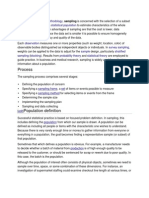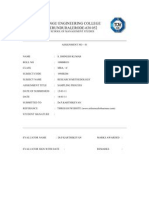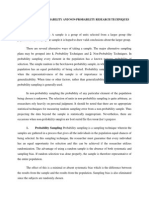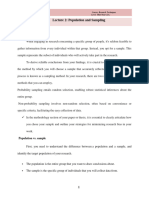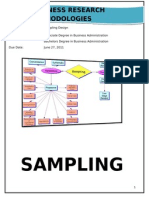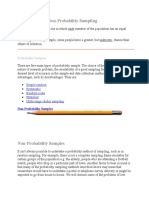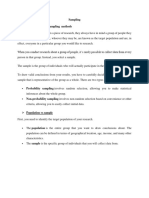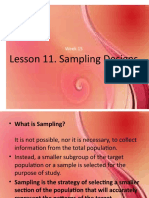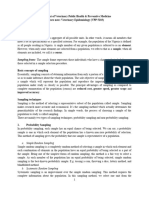Probability Vs Non-Probability Sampling
Probability Vs Non-Probability Sampling
Uploaded by
Masood IshfaqCopyright:
Available Formats
Probability Vs Non-Probability Sampling
Probability Vs Non-Probability Sampling
Uploaded by
Masood IshfaqOriginal Description:
Copyright
Available Formats
Share this document
Did you find this document useful?
Is this content inappropriate?
Copyright:
Available Formats
Probability Vs Non-Probability Sampling
Probability Vs Non-Probability Sampling
Uploaded by
Masood IshfaqCopyright:
Available Formats
Reections on Probability vs Nonprobability Sampling
Jan Wretman
1
A few fundamental things are briey discussed. First: What is called probability sampling in
real life does not usually satisfy the conditions of the text-book denition, because of
nonsampling errors. Next: With quality assessment in the context of nonprobability sampling,
nonprobabilistic reasoning of a more ad hoc character has to be used. Finally: With quality
assessment of panel surveys, many aspects have to be taken care of.
Key words: Nonsampling errors; quality assessment; panel surveys.
1. Introduction
Being a statistician, I have been indoctrinated to look at nonprobability sampling with
suspicion. In this paper, however, I will attempt to discuss probability vs. nonprobability
sampling rather dispassionately, and I am not going to explicitly attack or defend one of
them (although it may perhaps be possible to read between the lines where my sympathies
are). My goal is simply to try to clarify a few elementary things to myself.
First, I consider what survey statisticians actually mean when they say that they are
using probability sampling. If we stick very strictly to the text-book denition, it must be
very unusual for an observed sample to be a probability sample, because of the
nonsampling errors that are always present.
Next, I consider how survey quality is presented. While the quality of probability
sample surveys is to a large extent discussed in well-established statistical terms, such as
bias and variance, which can be interpreted (from a design-based perspective) with
reference to long run frequencies in a hypothetical series of repeated trials, the quality of
nonprobability sample surveys is discussed in a more ad hoc fashion in terms of hopes and
misgivings, focusing on whether the actual sample can be believed to give a good image of
the population. Note, however, that even with probability samples, the possible effect of
certain nonsampling errors such as nonresponse and frame imperfections is usually
discussed in similar ad hoc terms of hopes and misgivings, without probabilistic
interpretation. Of course, if certain model assumptions are made, it would be possible to
use terms such as bias and variance also with a nonprobability sample survey, but now
under a model-based interpretation. This kind of model-based quality reasoning is,
however, completely outside the scope of the present paper.
Finally, quality assessment of panel surveys will be briey discussed, as an example,
where both probability and nonprobability elements may enter into the picture.
1
Department of Statistics, Stockholm University, SE-106 91 Stockholm, Sweden. Email:
jan.wretman@stat.su.se
Ofcial Statistics in Honour of Daniel Thorburn, pp. 2935
Needless to say, the discussion in this paper is from a statisticians point of view, which
may be different from the point of view of those who are doing market, opinion, or social
research in real life. I also want to make it clear that what I am discussing here is
probability vs. nonprobability sampling only in the context of quantitative research. With
qualitative research, the discussion would be quite different.
2. What is Probability Sampling in Real Life?
There are many ways of selecting a sample of units from a nite population. In text-books
in survey sampling, a certain class of sampling procedures is said to constitute the class of
probability sampling procedures, in contrast to the remaining class of nonprobability
sampling procedures. Under ideal text-book conditions, probability sampling is usually
described along the following lines:
(1) A sample of units is to be selected from the population, using some known
randomization mechanism.
(2) It is possible (at least in principle) to list all the samples that can be obtained using
this procedure.
(3) We know the probability of each possible sample, when this procedure is used.
(4) For each unit in the population we can nd its inclusion probability, that is, the
probability that it will be selected. The inclusion probability can be obtained, for
example, by adding the probabilities of all the possible samples that contain this
special unit.
(5) Each unit in the population is to have a strictly positive inclusion probability. This is a
necessary and sufcient condition for the existence of an unbiased estimator of the
population total.
In real life, however, disturbances will usually occur, so that one or more of the ve
conditions above will not be satised, even when the expressed ambition is to use
probability sampling. One imperfection is that the selection of units is often done from a
sampling frame which does not entirely coincide with the population that one wants to
draw a sample from. In other words, the frame population is not identical with the target
population. There may, for example, be undercoverage, which means that there are units in
the target population that are missing in the sampling frame. These units can never be
selected and thus have an inclusion probability equal to zero, which is in conict with
Condition (5) above.
Another imperfection is caused by nonresponse, which means that data are not obtained
(for various reasons) from some units in the sample. Thus, there is an original sample, s,
selected by probability sampling from the sampling frame, and a smaller nal sample, s
(a subset of s), for which we have observed data. The reduction of s to s cannot be
described as probability sampling, because there are unknown response mechanisms
outside of our control. So the whole procedure resulting in the nal sample s cannot be
described as probability sampling, because a number of the ve conditions above are
violated.
Probability sampling is a prestige term among serious survey workers, and big actors
like national statistical agencies usually use what they call probability sampling in their
Ofcial Statistics in Honour of Daniel Thorburn 30
surveys. But, as we have seen above, the conditions of probability sampling are hardly
ever strictly satised in practice. So what does probability sampling actually mean in
real life?
It seems that the term probability sampling is used in real life to describe a procedure
where an original sample, s, is selected according to Rules (1) (5), resulting in a nal
sample, s, where the disturbances, such as undercoverage and nonresponse, are deemed
not too big. And what is not too big? There is no exact answer, but perhaps one could say
that disturbances are seen as not too big when they can be handled to a satisfactory extent
using methods agreed on by the responsible statisticians. Such methods are not
randomization based, but usually rely on various model assumptions. And what is
satisfactory extent? It probably varies from time to time. For example, what is
considered as an acceptable nonresponse rate today was not acceptable forty years ago. So
the answer to the question What is probability sampling in real life? is admittedly
somewhat vague. In what follows, whenever the term probability sampling is used, it is
to be understood as real life probability sampling.
3. And What is Nonprobability Sampling?
Any sampling procedure where the nal sample s is not obtained by means of real life
probability sampling will be classied here as a nonprobability sampling procedure.
Typically, there are no known inclusion probabilities, and sometimes there is not even an
exactly dened population. A few well-known examples of nonprobability selection
procedures are the following:
Self-selected respondents. An invitation to answer a number of questions is given to a
large (and often not well-dened) group of people, for example by announcement in a
newspaper or on an internet site. Anyone who reads the invitation is allowed to answer, but
usually only a very small fraction do in fact respond.
Respondents selected by interviewers. The interviewers have the freedom to select
people to interview, for example, in the street or in a shopping mall. Sometimes the
freedom is restricted by quota rules, saying that there has to be, for example, the same
number of men and women.
Respondents selected by experts. An expert or a researcher contacts a number of persons
who happen to be available and who are believed in some sense to be typical members of
the larger group of people that one is really interested in.
Snowball sampling. This is a technique to get in contact with people from an evasive
population, for example a population of homeless persons or of drug addicts. Initially, a
small group of already known people from the population are contacted and asked to
identify other people they know from the same population. Then, these new people are
contacted and asked in their turn to identify people they know from the population, and so
on, until a certain number of people have been identied who will then together make up
the sample.
There are also selection procedures where a certain amount of randomness is actually
involved but where the nal sample of respondents might nevertheless be considered as a
nonprobability sample, because the disturbances or deviations from strict probability
sampling are too large. Two examples follow:
Wretman: Probability and Nonprobability Sampling 31
Unknown number of nonrespondents. Interviewers are calling people on the phone until
a prescribed number of respondents is obtained, but there is no registration of how many
calls have to be made in order to get the desired number of answers. Even if the phone
numbers were selected in some randomized fashion, the nal sample of respondents would
probably be considered as a nonprobability sample, and recognized estimation techniques
(thought out for probability sampling) would not be used.
Known, but prohibitively large nonresponse. Say that an original sample is selected by
probability sampling from an acceptable sampling frame according to all the recognized
rules, but that the nonresponse is extremely large, say, 70 percent. Even here the nal
sample (30 percent of the original sample) would probably be considered as a
nonprobability sample and recognized estimation techniques would not be used.
Unfortunately, as seen in these two examples, there is no sharp boundary line between
probability and nonprobability sampling. It is to some extent a matter of judgement.
4. Quality Assessment with Nonprobability Sampling
The question in focus here is the following: Is there a sufciently small difference between
the obtained estimate and the true value of the population parameter being estimated?
Since the true parameter value is unknown, one can never nd out exactly how large this
difference is. What one can do is to present various indicators that are assumed to give
more or less information about the quality.
With probability sampling, statements are made about bias and variance of the
estimators, and condence intervals are calculated, which can be given a long run
frequency interpretation. Statements are also added about possible effects of frame
imperfection, nonresponse, measurement error, and other sources of nonsampling error.
With nonprobability sampling the situation is different, and the traditional quality
indicators from probability sampling can no longer be used. Often, the population is not as
well-dened as it usually is in the probability sampling context. In opinion surveys one can
sometimes see sweeping formulations such as the general population. It is no longer
possible to use design-based terms such as bias, variance, and condence intervals, since
there are no design probabilities involved. (As already pointed out, the possibility of
model-based quality discussion is outside the scope of this paper). Usually no sampling
frame is being used, and it also seems meaningless to talk about nonresponse in the
traditional sense, since there is no original sample of selected units that one tries to contact,
with varying result. There is only the nal sample of responding units, and one does not
know how many people would have answered under some sort of ideal circumstances.
The only type of traditional error source that could be discussed seems to be the
measurement error, since question wording and questionnaire design may affect the
answers to the same extent whether the respondents have been selected by probability
sampling or not.
I want to remark on the use of the term bias. In quality presentations one can sometimes
see this term as referring to the difference between an observed estimate and the parameter
to be estimated, which is somewhat annoying for a statistician. Bias, as a statistical term,
means the expected value (not the realized value) of this difference. Thus, the term bias
should be used in a statistical context only when probabilities are involved.
Ofcial Statistics in Honour of Daniel Thorburn 32
When asking about the quality of a survey based on nonprobability sampling, another
type of questions have to be asked than in the probability sampling context. A few
examples follow here. We note that these questions focus on qualities of the actual sample
and the procedures used to obtain it, rather than average long run properties in a
hypothetical series of repeated trials.
Is there any reason to suspect that the survey participants are much different from the
population units with respect to the distribution of the study variable? Do they have
consistently higher values, or lower values? The hope is that the sample shall look like the
population as much as possible in the respects that are relevant. Of course, it is not usually
possible to know anything denitely about this. Perhaps one could get some information
by taking a closer look at the mechanisms that made people take part in the survey. Did a
certain type of people have a greater disposition to become respondents?
How are the survey participants distributed with respect to certain background
variables as compared to the corresponding distribution in the population? We then have
to assume (1) that some background variables (such as sex, age, and income) are known
for the whole population, and (2) that the study variable covaries with these known
background variables. Large differences then give rise to suspicion (while small
differences do not necessarily mean that the estimate is good).
Do we know anything about peoples willingness to take part in the survey? How many
of those who were exposed to the invitation did really answer? How many phone calls
were necessary to get the desired number of respondents? A high degree of unwillingness
may indicate that those who in fact respond may be unlike the majority of the population.
5. Quality Assessment with Panel Surveys
Surveys based on access panels (also called online panels) are being more and more
used these days in market, opinion, and social research. From a statistical point of view,
focusing on how people are selected, such surveys are essentially carried out in the
following two stages:
Stage 1. A number of people are selected to make up the access panel. This panel is then
to serve as a sampling frame over a long time for a number of future surveys of various
kinds. The panel may be obtained by probability sampling from a well-dened population,
or by some nonprobabilistic recruitment procedure. (Sometimes a panel may also be
obtained by merging a number of already existing panels, which could have been obtained
by different procedures.) Usually, people who have expressed a willingness to join the
panel will not automatically become panel members, but they rst have to satisfy some
eligibility requirements. Those who turn out to be eligible are then asked to give some
background information about themselves (which in this context is called prole data).
There will usually be some nonresponse in this process, but those people who nally
remain will make up the panel (sometimes called the active panel).
Stage 2. For an actual survey, a sample of people is drawn from the panel (or from a
suitable subset of the panel), either by probability sampling or nonprobability sampling.
There may be certain restrictions for example, that panel members could be exempted
from selection for some time in order to avoid overburdening and attrition, or to avoid
panel members being professionalized. Sometimes panel members are put in quarantine
Wretman: Probability and Nonprobability Sampling 33
for some time after participation in a survey. People who have not responded for a certain
number of consecutive surveys may be excluded from the panel. A panel is changing as
long as it exists, because people are leaving for various reasons and have to be replaced.
Data collection in panel surveys is usually carried out using the Web.
From a statistical point of view, the selection procedure in a panel survey has some (but
not perfect) similarity with two-phase sampling. In the rst phase, a big sample ( the
panel) is selected, and easily accessible background data ( prole data) is collected. In
the second phase, a subsample ( the sample for the actual survey) is selected from the
rst-phase sample, and data concerning the actual study variables is collected from that
subsample. A difference is that in traditional two-phase sampling it is always assumed that
probability sampling is used in both phases, which is not necessarily the case in the panel
survey context. A statistician might also nd that the panel can be seen as a kind of master
sample, kept over time, from which repeated subsamples are selected.
When judging the quality of a panel survey, two aspects must be distinguished, namely,
(1) the quality of the panel as such, and (2) the quality of the specic survey, based on a
subsample from the panel.
When studying the quality of the panel itself, the questions to be asked are to some
degree dependent on whether the panel is obtained by probability or nonprobability
sampling. In addition to the usual questions for these two cases, there are also questions of
a more panel specic nature. A few examples are as follows:
How was the recruitment carried out?
How many people responded to the recruitment announcement?
What were the eligibility requirements?
How many people remained after the eligibility check?
How many people remained after the prole survey?
How many active members are there in the panel now?
For how long have these panel members stayed in the panel?
In how many surveys have they participated?
How many people have left the panel for various reasons?
How is replacement carried out?
What is the policy to eliminate attrition and professionalization?
What other measures are taken to keep the panel in good shape?
What is the structure of the panel with respect to prole variables, such as sex, age, and
income?
Is there any reason to believe that the panel is in some respect different from the general
public?
When studying the quality of a specic panel survey as a whole, the quality of the panel is
of fundamental importance. But there are also quality aspects connected with what was
called Stage 2 above. The sample in Stage 2 may be selected by probability or
nonprobability sampling from the panel, and quality issues should be discussed in terms
appropriate for the case in point. Preferably, the two stages of the panel survey should be
considered in combination. What is their joint effect on the quality of the specic panel
survey? The nal inference is from the sample data to the population, via the panel.
Remember that as long as a panel is much different from the population, it does not help
Ofcial Statistics in Honour of Daniel Thorburn 34
very much if the panel sample gives a good image of the panel. The quality of the panel
itself is crucial.
6. Conclusion
Although probability sampling is a well-dened concept under ideal text-book conditions,
the borderline between probability and nonprobability sampling is a bit vague when it
comes to survey sampling in practice. Even when the ambition is to use strict probability
sampling, there will usually be disturbances caused by nonsampling errors, so that the text-
book conditions are no longer satised. If one should stick rigidly to the text-book
denition, probability sampling hardly ever exists in real life. But it seems that the term
probability sampling is still used by responsible survey statisticians, as long as the
disturbances are considered to be small. Unfortunately, a satisfactory agreement on what
should be meant by small is still lacking.
How to present the quality of statistics based on a probability sample is an issue that has
been discussed by statisticians for a long time, and it seems that a considerable consensus
has been reached. National statistical agencies and other big actors often have their own
guidelines on how quality should be reported to the users.
When it comes to quality declaration of statistics based on a nonprobability sample, the
situation is different. There are no general guidelines on how users should be informed
about the quality of statistical results. Of course, if certain statistical model assumptions
are made, the usual technical apparatus of statistical theory can be used for model-based
inference, but this type of survey is not discussed in the present paper. Instead, I have
wanted to draw attention to quality declaration of statistical results from nonprobability
surveys without model assumptions, which are often used, for example, in market and
opinion research. I think statisticians should not disregard this type of surveys, but rather
come up with concrete suggestions for declaration of quality, to make it easier for users to
judge how much they should believe in the results. It seems that with nonprobability
surveys (without model assumptions), quality should not be expressed so much by
numerical measures (such as nonresponse rates), but rather by verbal descriptions of the
procedures used, focusing on their potential weaknesses.
Wretman: Probability and Nonprobability Sampling 35
You might also like
- Human Relation ApproachDocument11 pagesHuman Relation ApproachJoginder Grewal100% (1)
- Research Methodology AssignmentDocument12 pagesResearch Methodology Assignmentshashank100% (1)
- ROHAN BRM AssignmentDocument6 pagesROHAN BRM AssignmentChethan KcNo ratings yet
- Non Probability SamplingDocument11 pagesNon Probability SamplingSyed Hasham AhmadNo ratings yet
- Lesson 3 - SamplingDocument32 pagesLesson 3 - SamplingrelebohilemochesaneNo ratings yet
- Probability and Non-ProbabilityDocument6 pagesProbability and Non-Probabilityzameer ahmedNo ratings yet
- Nonprobability SamplingDocument9 pagesNonprobability SamplingJayden TumataNo ratings yet
- Non Probability SamplingDocument3 pagesNon Probability SamplingenjoyevmomentNo ratings yet
- Sampling: Word Did Not Find Any Entries For Your Table of ContentsDocument5 pagesSampling: Word Did Not Find Any Entries For Your Table of ContentsGagan Jaiswal100% (1)
- Tutorial 3Document3 pagesTutorial 3Chandra250No ratings yet
- Sampling BasicsDocument14 pagesSampling BasicsRenganathan IyengarNo ratings yet
- Nonprobability Sampling: Accidental, Haphazard or Convenience SamplingDocument4 pagesNonprobability Sampling: Accidental, Haphazard or Convenience SamplingSyed Zulqarnain HaiderNo ratings yet
- Module 006 - Logic of Inferential StatisticsDocument13 pagesModule 006 - Logic of Inferential StatisticsIlovedocumintNo ratings yet
- Non Probability SamplingDocument9 pagesNon Probability SamplingJovelyn CariñoNo ratings yet
- Planning and Conducting A Study For AP StatisticsDocument6 pagesPlanning and Conducting A Study For AP StatisticsKairatTM100% (1)
- Process: Statistics Survey Methodology Statistical PopulationDocument14 pagesProcess: Statistics Survey Methodology Statistical PopulationKopal TandonNo ratings yet
- Sampling and Sample DesignDocument30 pagesSampling and Sample Designenad100% (1)
- Sampling Mixed Research MethodsDocument10 pagesSampling Mixed Research MethodsNana Ama Donkor-boatengNo ratings yet
- Sampling of DataDocument13 pagesSampling of DataNeha Tarun GuptaNo ratings yet
- Kongu Engineering College PERUNDURAI, ERODE-638 052Document14 pagesKongu Engineering College PERUNDURAI, ERODE-638 052dhanabalu87No ratings yet
- Sampling (Statistics) : For Computer Simulation, See Pseudo-Random Number SamplingDocument22 pagesSampling (Statistics) : For Computer Simulation, See Pseudo-Random Number Samplingmss_sikarwar3812No ratings yet
- Chapt 6 Evans Methods in Psychological Research 3eDocument15 pagesChapt 6 Evans Methods in Psychological Research 3eRhence TejeroNo ratings yet
- Research Methods Knowledge Base - Book - SAMPLINGDocument19 pagesResearch Methods Knowledge Base - Book - SAMPLINGXshan NnxNo ratings yet
- BUS 802 AssignmentDocument9 pagesBUS 802 AssignmentTochukwu CollinsNo ratings yet
- MATH& 146: Midterm Synopsis: CHAPTER 1: Stats Starts HereDocument44 pagesMATH& 146: Midterm Synopsis: CHAPTER 1: Stats Starts Herecharity joyNo ratings yet
- Selecting A Sample: VotersDocument10 pagesSelecting A Sample: Voterskrishna vargasNo ratings yet
- Q2 - RDL1 Week 3Document4 pagesQ2 - RDL1 Week 3Chris Ann ArevaloNo ratings yet
- Nonprobability SamplingDocument21 pagesNonprobability SamplingAnonymous N0mQBENo ratings yet
- RM 7Document47 pagesRM 7janreycatuday.manceraNo ratings yet
- Sample Surveys and Sampling MethodsDocument28 pagesSample Surveys and Sampling MethodskkathrynannaNo ratings yet
- Research Methods and Applied StatisticsDocument10 pagesResearch Methods and Applied StatisticsGeerthana ArasuNo ratings yet
- 3 SamplingDocument14 pages3 SamplingKhyati JadavNo ratings yet
- Sample Definition: A Sample Is A Group of Units Selected From A Larger Group (TheDocument7 pagesSample Definition: A Sample Is A Group of Units Selected From A Larger Group (Theaqsa_sheikh3294No ratings yet
- Probability Versus Non Probability SamplingDocument5 pagesProbability Versus Non Probability SamplingDivyansh JainNo ratings yet
- Ho Coms 120 Research MethodologyDocument6 pagesHo Coms 120 Research MethodologyBryan RonoNo ratings yet
- Research Design Lecture Notes UNIT IIDocument12 pagesResearch Design Lecture Notes UNIT IIAmit KumarNo ratings yet
- Lecture 2 SamplingDocument9 pagesLecture 2 Samplingbouali1419No ratings yet
- Chapter Four Sample Design and ProcedureDocument13 pagesChapter Four Sample Design and ProcedureBete AmdNo ratings yet
- Sampling in ResearchDocument8 pagesSampling in ResearchTricia MeiNo ratings yet
- Chapter 5 - SamplingDocument56 pagesChapter 5 - SamplingElenear De OcampoNo ratings yet
- Sampling: Business Research MethodologiesDocument21 pagesSampling: Business Research MethodologiesJames DavisNo ratings yet
- QT-UNIT IVDocument15 pagesQT-UNIT IVDr.P. Siva RamakrishnaNo ratings yet
- Probability and NonDocument4 pagesProbability and NonPrabhat Kumar SinghNo ratings yet
- Probability and NonDocument4 pagesProbability and NonPrabhat Kumar SinghNo ratings yet
- Sampling Methods 6 and 7 AprilDocument18 pagesSampling Methods 6 and 7 AprilHimanshuNo ratings yet
- Sampling (Statistics)Document15 pagesSampling (Statistics)RajendersinghsssNo ratings yet
- 112 StatDocument5 pages112 StatLoojee BaylesNo ratings yet
- Sample Types and Errors in ResearchDocument3 pagesSample Types and Errors in Researchamrin jannatNo ratings yet
- 5 Quantitative Data CollectionDocument18 pages5 Quantitative Data CollectionfatemehNo ratings yet
- Techniques of SamplingDocument5 pagesTechniques of SamplingamarthyeshwarsaipNo ratings yet
- Sampling Frame Set Sampling MethodDocument18 pagesSampling Frame Set Sampling Methodpreethu_687No ratings yet
- Sampling A LevelDocument14 pagesSampling A LevelazairrusNo ratings yet
- Sampling DesignDocument15 pagesSampling Designfarmerfreak1771No ratings yet
- FNR Material For Lesson XI 2022Document32 pagesFNR Material For Lesson XI 2022Anna Marie PadulNo ratings yet
- SamplingDocument5 pagesSamplingBashiru GarbaNo ratings yet
- Unit Sampling Concept, Significance and Types: .3.0 ObjectivesDocument14 pagesUnit Sampling Concept, Significance and Types: .3.0 ObjectivesSakhi K246No ratings yet
- StatDocument4 pagesStatMe selfNo ratings yet
- Statistics Essentials Dummies - Chapter 12Document9 pagesStatistics Essentials Dummies - Chapter 12A FrancesNo ratings yet
- Q2 Module 2 - Sample and Sampling TechniquesDocument8 pagesQ2 Module 2 - Sample and Sampling TechniquesJester Guballa de LeonNo ratings yet
- The Strange Ways of Chance: A Lay Guide to Uncertainty in Medicine, Sports, Finance, Crime, and MoreFrom EverandThe Strange Ways of Chance: A Lay Guide to Uncertainty in Medicine, Sports, Finance, Crime, and MoreNo ratings yet
- Department Financial Advisory - Uk Offices: Job SummaryDocument2 pagesDepartment Financial Advisory - Uk Offices: Job SummaryMasood IshfaqNo ratings yet
- SOBCDocument1 pageSOBCMasood IshfaqNo ratings yet
- Recruitment of 5 Batch of Officers (OG1) at SBP-Banking Services CorporationDocument1 pageRecruitment of 5 Batch of Officers (OG1) at SBP-Banking Services CorporationMasood IshfaqNo ratings yet
- PCC Information FormDocument1 pagePCC Information FormMasood IshfaqNo ratings yet
- Hotel Zaza Case Study FinalDocument6 pagesHotel Zaza Case Study FinalMasood IshfaqNo ratings yet
- Assignment Artificial Intelligence: NamesDocument5 pagesAssignment Artificial Intelligence: NamesMasood IshfaqNo ratings yet
- Research Proposal 2Document55 pagesResearch Proposal 2Tibin JosephNo ratings yet
- Specimen of Affidavit 2011Document1 pageSpecimen of Affidavit 2011Masood IshfaqNo ratings yet
- ISO-9001 & 14001 - 2015-TrainingDocument24 pagesISO-9001 & 14001 - 2015-TrainingKranti Crank100% (1)
- Electronic Commerce Research and Applications: Changsu Kim, Wang Tao, Namchul Shin, Ki-Soo KimDocument12 pagesElectronic Commerce Research and Applications: Changsu Kim, Wang Tao, Namchul Shin, Ki-Soo KimPrima Ratna SariNo ratings yet
- MBA (36 Credits) Sample Question Paper: SzabistDocument4 pagesMBA (36 Credits) Sample Question Paper: SzabistOppo A37No ratings yet
- I-49 Inner-City Connector Study Corridor 3ADocument11 pagesI-49 Inner-City Connector Study Corridor 3ACurtisNo ratings yet
- Implementation of Solid Waste Management in Bulihan National High SchoolDocument3 pagesImplementation of Solid Waste Management in Bulihan National High SchoolboyetNo ratings yet
- Solfeggio Frequencies Make Up The Ancient 6Document5 pagesSolfeggio Frequencies Make Up The Ancient 6agnes100% (1)
- Schwartz - An Alternative Method For System SizingDocument4 pagesSchwartz - An Alternative Method For System SizingRyanRamroopNo ratings yet
- Manuale Inglese Kestrel 5500Document11 pagesManuale Inglese Kestrel 5500yoel pumaNo ratings yet
- SanyasaDocument7 pagesSanyasaa1n2u3s4h5a6No ratings yet
- B.O.Q PreparationDocument7 pagesB.O.Q PreparationYelisa Danny DenzelNo ratings yet
- Try This Game I Found OnlineDocument10 pagesTry This Game I Found OnlineJerome Agpaoa ManioNo ratings yet
- AIDocument2 pagesAIPriya PreethiNo ratings yet
- Lecture6 EvapotranspirationDocument66 pagesLecture6 EvapotranspirationIvy AlNo ratings yet
- The Government-Academia Complex and Big Data ReligionDocument8 pagesThe Government-Academia Complex and Big Data ReligionFrancisco AraújoNo ratings yet
- Control Moment Gyroscope ExperimentDocument8 pagesControl Moment Gyroscope ExperimentMohammed FarisNo ratings yet
- Discover Your Next Level: The Aston Online MbaDocument11 pagesDiscover Your Next Level: The Aston Online MbaSam Sep A SixtyoneNo ratings yet
- Project Report SaketDocument46 pagesProject Report SaketAlicia BennettNo ratings yet
- Inside A "Fake" Conference - A Journey Into Predatory ScienceDocument10 pagesInside A "Fake" Conference - A Journey Into Predatory Scienceummi.aurora.2017No ratings yet
- Combinational Logic Circuits: Dr. C. Saritha Lecturer in Electronics SSBN Degree and PG College AnantapurDocument23 pagesCombinational Logic Circuits: Dr. C. Saritha Lecturer in Electronics SSBN Degree and PG College AnantapurerdvkNo ratings yet
- Usp/Nsc MICROCODE VERSION 50-09-82-00/00 RELEASED 01/07/2009 Newly Supported Features and Functions For Version 50-09-82-00/00Document5 pagesUsp/Nsc MICROCODE VERSION 50-09-82-00/00 RELEASED 01/07/2009 Newly Supported Features and Functions For Version 50-09-82-00/00imkzbyNo ratings yet
- Instant Download Introduction To Communication and Artificial Intelligence David J. Gunkel An David J. Gunkel PDF All ChapterDocument34 pagesInstant Download Introduction To Communication and Artificial Intelligence David J. Gunkel An David J. Gunkel PDF All Chaptergjowaiq100% (2)
- MOS Site ClearingDocument4 pagesMOS Site ClearingMohd HafizanNo ratings yet
- Manual Deflectómetro DynatestDocument33 pagesManual Deflectómetro DynatestNicolás Adones AguileraNo ratings yet
- Ready Set Leap Ebook 3Document20 pagesReady Set Leap Ebook 3Rosa FerreiraNo ratings yet
- Fpsyg 12 663440Document5 pagesFpsyg 12 663440samijanjua.kbcNo ratings yet
- Examining Images That Present Viewpoints and OpinionsDocument10 pagesExamining Images That Present Viewpoints and OpinionsWendy MagnayeNo ratings yet
- Beating The Odds When You Launch A New Venture by Clark G. Gilbert and Matthew J. EyrinDocument5 pagesBeating The Odds When You Launch A New Venture by Clark G. Gilbert and Matthew J. Eyrinvipinkrk-1No ratings yet
- Nebosh Igc Q/aDocument7 pagesNebosh Igc Q/amunawar100% (1)
- Chinese CLIP: Contrastive Vision-Language Pretraining in ChineseDocument18 pagesChinese CLIP: Contrastive Vision-Language Pretraining in Chinese20135A0504 CHAVAKULA VIJAYA RAMA KRISHNANo ratings yet















